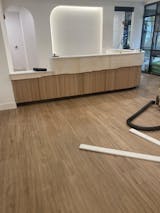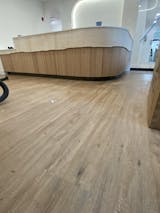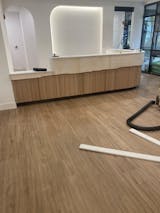Flexible Wood Tambour is a versatile and elegant solution for interior design, offering a unique blend of aesthetic appeal and practical functionality. Ideal for adding a touch of natural warmth and sophistication to any space, this product requires careful handling and specific installation procedures to maintain its integrity and appearance. It's crucial to understand the appropriate storage, handling, finishing, and installation techniques to ensure the best results and longevity of the tambour panels. This guide provides detailed instructions on how to manage Flexible Wood Tambour effectively, from the moment it is received to its final installation, ensuring that the material retains its beauty and functionality in your interior space.
Flexible Wood Tambour
Storage & Handling
• Flexible Wood Tambour is intended for interior use only and is not designed for wet areas or locations with high humidity such as showers, bathrooms or pools.
• Upon receipt of material, tambour panels must be stored in a controlled environment and should be allowed 24 to 48 hours to acclimate. This is best done with the panels lying flat on a horizontal surface.
• Prior to installation or shop finishing, tambour panels should be lightly rolled/unrolled to flex the backing sheet. Hold for 5+ seconds in rolled position before returning to flat.
Finishing
• Flexible Wood Tambour panels can be finished using standard wood finishing techniques, either before or after installation.
• Panels can be allowed to roll or “slump” slightly to allow finish to reach between wood slats.
Installation
• Flexible Wood Tambour panels can be installed vertically or horizontally and should be dry-fit prior to applying adhesive.
• Be sure the substrate/wall surface is clean from any debris/dirt/dust/grease.
• Install tambour panels only in a controlled environment (standard room temperature/humidity).
• Off-the-shelf PVA, contact adhesive, epoxy, or high-quality panel adhesives such as TiteBond Fast Grab FRP Adhesive may be used.
• If using panel adhesive, troweled-on, full-coverage (80-100%) to within ¼” of panel edge is recommended. If applying with a caulk gun, include continuous bead around perimeter as well as horizontal beads every 4-6”.
• Clean/remove any excess adhesive to prevent “spill-over” from getting on the face of the tambour slats.
• For best results, test a small area for proper adhesions prior to full installation.
• Trim screws or nails can be used at the customer’s discretion.
• Apply full and firm pressure over the entire panel to ensure continuous bond. A ¾” thick sacrificial board should be used when tapping/hammering the tambour panel in place.
• Adjacent panels should not be butted against one another too tightly, as some minor movement in service is expected.
• Do not mount/fasten furniture or cabinetry through tambour panels to the wall. Movement of the furniture or cabinetry can cause buckling or improper fit/adhesion of the tambour panels and will void warranty.
1. Before attaching the tambour panel, it's important to stretch it out. To do this, roll the panel inward.
2. To prepare the tambour panel, flex it outward with a considerable amount of force. This action is necessary to stretch the panel's paper backing thoroughly. After adequately stretching, the panel will become noticeably more flexible in all directions.
3. When installing the panels, it's important to leave small gaps between them. A useful guide is to ensure these gaps are roughly the thickness of two stacked business cards. Allowing these small spaces is crucial as it provides room for the wood to naturally expand and contract post-installation.









